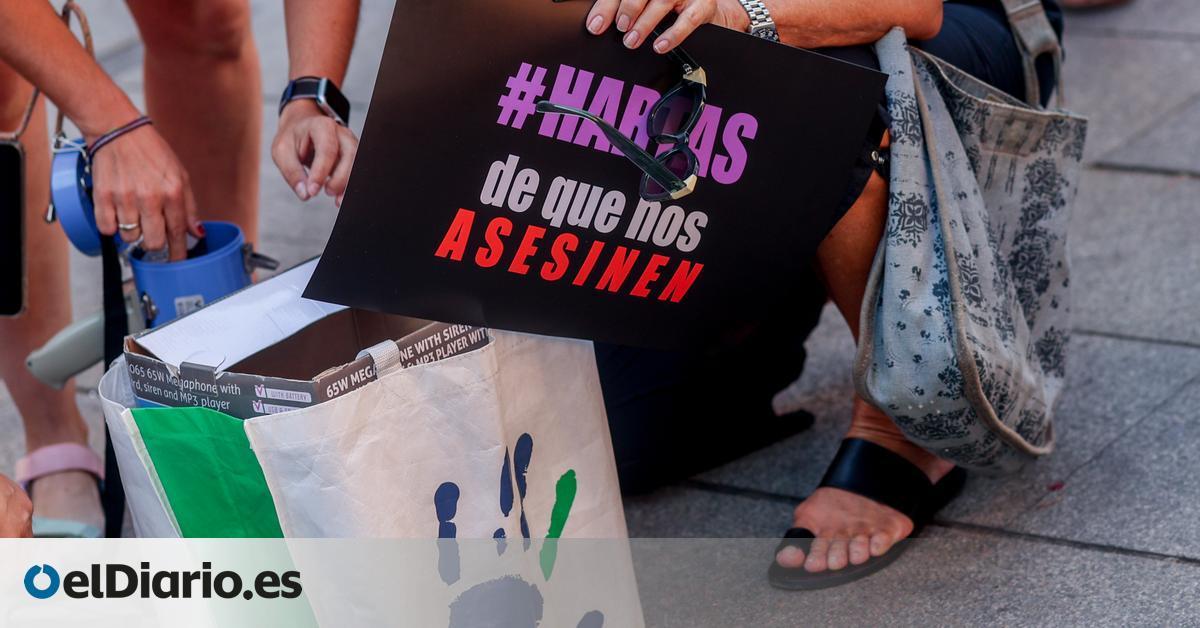
That day Maialen did not come to the family meal. Her lifeless body lay in the room of an aparthotel in Vitoria, along with her three-year-old daughter. His murderer, Jaime Roca, was arrested by the Civil Guard near Zaragoza shortly after, when he tried to flee in a taxi. He had a restraining order against him, the case was registered in the VioGén system with “high” risk, but the man ended up killing his partner, who was pregnant with twins.
Men who kill their partners during separation: the factor that reveals what lies behind sexist violence
Further
Maialen’s became the twentieth murder due to sexist violence so far in 2023. The counter that resets to zero every year – but has already accumulated 1,232 fatalities since 2003 – has not stopped rising since then. And it does so at a rate that has set off alarm bells: in the summer months alone (July and August and the 24 days of September) 23 women have been murdered by their partners or ex-partners. It is a murder every almost four days.
There are 48 so far this year, a figure much higher than that recorded in the last three. Although we must bear in mind that we are talking about differences that are statistically small, we must go back to September 2010, when at this point there were 51 cases, to find a record higher. In 2019, a year that ended with 56 crimes, this month 47 were recorded, one less. Even so, a more global look allows us to deduce a decrease after the entry into force of the Gender Violence Law: in two decades of application it has gone from 69 murders on average in the first five years to 51 in the last ones.
Maialen’s murder occurred at the end of May, a month in which six cases occurred and which ended with the convening of a crisis committee, the body created by the Ministry of Equality to analyze each of the murders and locate possible failures. These meetings are held when five or more crimes occur in the same month, something that has happened on up to four occasions since January. Equality has already convened the next committee for next October 4 in light of the eight murders in September.
The exchange of information between administrations always results in a series of conclusions and proposals that are not directly applicable, but serve to identify the gaps in the system in the protection of victims. In the crisis committee that analyzed the murders, which included that of Maialen, for example, it was called to review pregnancy as a risk factor when evaluating it and the professionals with whom the victims meet were urged to Be proactive in identifying the resources to which you are entitled.
Expand the magnifying glass
And the fact is that the State reaches where women are is one of the most repeated conclusions this year: reaching where violence occurs and not waiting for the victims to report as the only way out of violence. The objective is to bring to light hidden, unreported abuse, which is the vast majority. According to data so far this year, only nine of the 48 victims, 18%, had gone to a police station or court to ask for help.
The Government delegate against Gender Violence, Victoria Rosell, emphasizes however that practically all the women who have been murdered, except those who have just landed in Spain or are spending a few days on vacation, had had contact with some institution, be it health, educational, police or social services. “We have the obligation to detect gender violence and to put in place all the means, protocols and training for it,” she says.
There are women who go to the emergency room even from different locations with serious injuries. Violence that is easier to detect and yet sometimes escapes from your file even though it is evident that there is an abnormal pattern of injury.
Victoria Rosell
— Government Delegate against Gender Violence
Rosell assures that from the health field this violence can be detected from the mental health or emergency departments, but also gynecology and obstetrics or pediatrics. “There are abused women who go to the emergency room even with serious injuries. When we talk about the most flagrant violence and which is therefore easier to detect, even so, sometimes in your file that escapes even though it is evident that there is an abnormal pattern of injury,” she explains.
The same can happen in the educational field, formal and informal, or in social services: “If professionals were very aware of the figures, which say for example that 57.3% of women in Spain have suffered some type of violence sexist, perhaps sexual or sexist jokes that make women feel in unsafe places would not be made and more cases could be detected, the magnifying glass would also be expanded,” says Rosell.
The psychologist specialized in accompanying victims of gender violence alludes to the same thing. “A very important leg is missing, which is coordination between different areas. From the psychology services we should be able to coordinate with health centers or educational centers for their sons and daughters, for example, and that would allow for more complete support,” believes the expert, who also emphasizes that public resources for psychological care “are limited” and sometimes do not allow addressing “complex traumas” that “take years of therapy.”
Even so, he believes that institutions “are becoming very active” although “some more than others.” An example is the so-called “enabling title” implemented at the state level, which allows a woman’s status as a victim to be accredited to access resources and rights without the obligation to report. Although it is a civil accreditation, that is, it does not serve to dictate measures against the aggressor, such as restraining orders or protection, it does allow women to “enter a system of gender experts who will help and guide them, that accompany them, and there women are more capable of detecting, telling and empowering themselves,” believes Rosell.
Complicit silence
The silence of the victims’ environment is also another of the factors that institutions have identified in this year’s murders as an element that ends up leaving women unprotected. The Ministry of Equality has called it “complicit and concealing silence” of sexist violence and this is how the Supreme Court described it in a pioneering ruling in 2019 in which it stated that this situation “causes and contributes” to the concealment of the victims. .
It is contradictory that on the one hand we try to get victims to report and on the other there are voices that encourage denialism
Mercedes Alcañiz
— Sociologist from the Jaume I University
Mercedes Alcañiz, sociologist and gender expert at the Jaume I University of Castellón, agrees on the importance of addressing this silence from family and friends. “There is still a normalization of violence, not so much of the most obvious, which is physical. But with psychological violence and control, which on the other hand is the most common, we can have a victim next to us and not perceive her as such, perhaps not even she does… Sometimes something very serious and explicit has to happen. to react,” says the expert.
But the opposite of breaking the silence is, however, trying to dilute sexist violence and deny its specificity in a discourse championed by Vox and related social and political sectors. The increase in power of the extreme right, which thanks to pacts with the Popular Party, has entered city councils and governments of autonomous communities also worries experts. “Right now we cannot rigorously know what consequences it will have but it is clearly contradictory that on the one hand we try to get the victims to report and on the other there are voices that encourage denialism,” says Alcañiz.
The Government delegate against Gender Violence provides one more nuance. This discourse is not only supporting the silence of the victims, but also emboldens the aggressors with messages “that reaffirm the most violent masculinities,” she says. Rosell also speaks of a “symbolic violence” against women that “feeds back hatred.” As an example, she mentions the tweets that both the account of the Government Delegation against Gender Violence and she post communicating and lamenting sexist murders: “They respond to us with insults.”
Vulnerable victims due to precariousness
The conclusions of the crisis committees have pointed to the economic precariousness of the victims as an element that slows the escape from violence. Precisely in the first meeting held this year for the seven murders in January, this factor was realized: in two of the cases evaluated, the women continued to live with their murderers only because they did not have a housing alternative and they cohabited with the aggressor solely for economic reasons. after having separated.
Employment “reduces situations of economic dependency” that often links women to aggressors, highlights the latest report from the Adecco Foundation
It has been proven that in times of economic crisis the number of complaints is reduced. Unemployment, salary cuts and increased family burdens usually deter victims and this was the case in the 2008 recession and the one suffered as a result of the coronavirus. Employment “reduces situations of economic dependency” that often links women to aggressors, highlights the latest report from the Adecco Foundation, based on interviews with victims. For the Women’s Institute, having a job “is essential for their recovery” due to the “autonomy it provides.”
But it’s not just about having a job. And it is not uncommon for salaries to not be enough to pay for housing and cover expenses. Precariousness in a broad sense “has a lot of influence,” highlights Rosell, especially in access to a house. “We have witnessed murders of women who did not live with their attackers because they were in a relationship, the relationship was broken, but they did so because of lack of housing. That increased the risk they were in. We are even talking about women who have a restraining order but who have continued in contact with the aggressor due to precariousness, because they had no one to leave the children with to go to work and they left them to him. We say that gender violence occurs in all social classes and that is true, but those who have no possibility of finding a roof over their heads, those who are more precarious, are more in danger.”
The proposal that the institutions arrived at after the meeting in which they specifically addressed this issue was that victims without resources and at high risk could practically automatically access housing and aid such as the Minimum Living Income after reporting. A measure that, however, has not yet been carried out. The committees identify gaps and failures in the chain of protection for women and point to possible solutions, but, at least for now, the proposals have become more calls for attention than effective measures.
Source: www.eldiario.es

